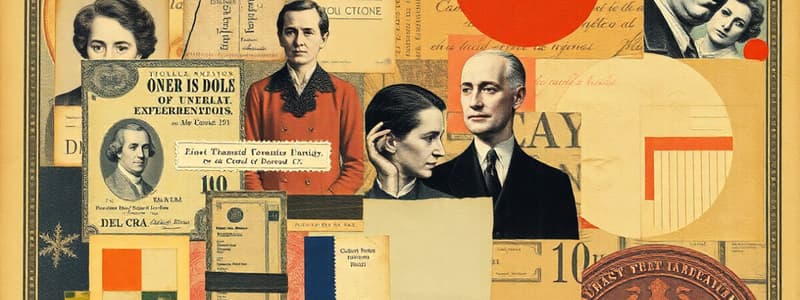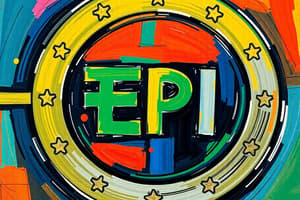Podcast
Questions and Answers
What is the primary function of CamScanner?
What is the primary function of CamScanner?
- To edit videos
- To create presentations
- To manage email
- To scan documents (correct)
Which feature is typically NOT associated with CamScanner?
Which feature is typically NOT associated with CamScanner?
- Document sharing
- Optical Character Recognition (OCR)
- Video conferencing (correct)
- PDF conversion
CamScanner allows users to perform which of the following tasks?
CamScanner allows users to perform which of the following tasks?
- Crop scanned images (correct)
- Send fax documents
- Make voice calls
- Design graphics
Which platform is NOT typically supported by CamScanner?
Which platform is NOT typically supported by CamScanner?
What type of content can be scanned with CamScanner?
What type of content can be scanned with CamScanner?
Flashcards
What is CamScanner?
What is CamScanner?
CamScanner is a mobile app that allows users to scan documents, photos, and other paper-based materials using their smartphone camera, creating digital copies that can be easily shared, edited, and stored.
How does CamScanner work?
How does CamScanner work?
CamScanner uses your phone's camera to capture images of documents. It then automatically detects the edges of the document and crops the image to remove any unnecessary background.
What can you do with CamScanner after scanning?
What can you do with CamScanner after scanning?
Once a document is scanned, CamScanner allows you to edit it, enhancing the clarity and readability. It can brighten, sharpen, and even adjust the colors.
How can I share my scan?
How can I share my scan?
Signup and view all the flashcards
How can I stay organized with CamScanner?
How can I stay organized with CamScanner?
Signup and view all the flashcards
Study Notes
Monetary Transmission Mechanism
- The monetary transmission mechanism refers to the channels through which changes in the money supply affect aggregate expenditure, prices, income, and other real variables in an economy.
Classical Theory
- In the classical theory, a change in the money supply does not affect real variables like output, employment, and income. Money is considered neutral in its impact on the economy.
- The analysis is based on a direct and mechanical relationship between money and prices. If the money supply increases, the price level rises proportionally, and vice versa.
- This relationship is described by the Quantity Theory Equation: MV = PT (where M is the money supply, V is the velocity of money, P is the price level, and T is the volume of transactions).
- The supply of real cash balances (M/P) must equal the demand for real cash balances (VT).
- The classical theory identifies two channels through which monetary changes impact the real sector: direct and indirect mechanisms.
Direct Mechanism
- The Direct Mechanism is based on the long-run equilibrium of the demand for and supply of money.
- Increases in money supply lead to an increase in the supply of money balances exceeding the demand for them.
- This results in adjustments in the price level to maintain equilibrium.
Indirect Mechanism
- This mechanism is not discussed in detail.
Keynesian Theory
- The Keynesian transmission mechanism focuses on the interest rate as the primary channel.
- Money is held for precautionary, transactions, and speculative motives. Demand for money is negatively related to the interest rate.
- Changes in the money supply affect aggregate expenditure indirectly through changes in interest rates.
- Monetary policy influences interest rates, which, in turn, impact investment and expenditure.
- A decrease in the interest rate stimulates investment, leading to an increase in aggregate demand, output, and employment.
- The transmission mechanism includes the asset effect (money holdings change due to changes).
- This process is influenced by expectations concerning future interest rates.
Monetarism
- The monetarist theory views the transmission mechanism primarily as a portfolio adjustment process.
- Changes in money supply affect various economic variables because people shift their assets based on these changes in the supply.
- The changes in cash balances affect the demand for goods and services.
- The main channels are wealth effect, substitution, and expected inflation.
Neo-Keynesian Theory
- The Neo-Keynesian theory expands the portfolio of assets beyond cash and bonds, recognizing a broader range of factors.
- Changes in the money supply affect the wealth of economic actors, which can influence their spending decisions.
- Substitution of assets, particularly between money and other assets, plays a key role in the transmission mechanism.
- Changes in the money supply affect interest rates, and thus investment, causing fluctuations in output and employment.
Credit Availability Effect
-
These effects relate to credit rationing, which is often non-price-based.
-
Credit rations are influenced by the quantity of loans available.
-
Loan availability depends on the type of borrower and their credit rating.
-
This affects the ability of borrowers to obtain funding, which then influences expenditure, investment, and aggregate economic activity.
Studying That Suits You
Use AI to generate personalized quizzes and flashcards to suit your learning preferences.




